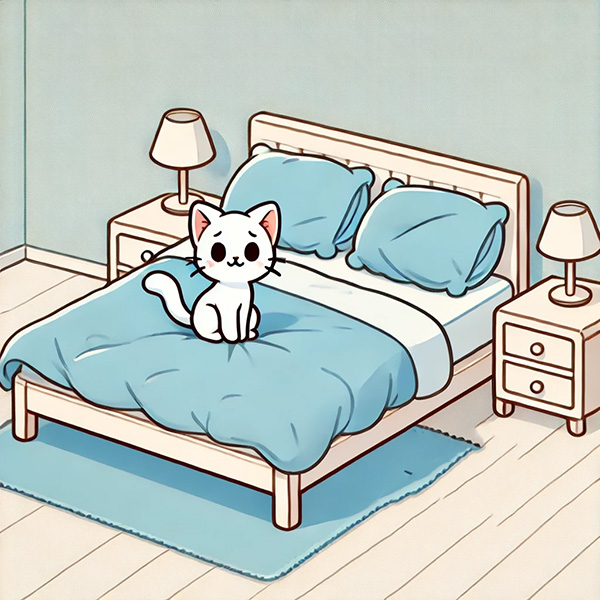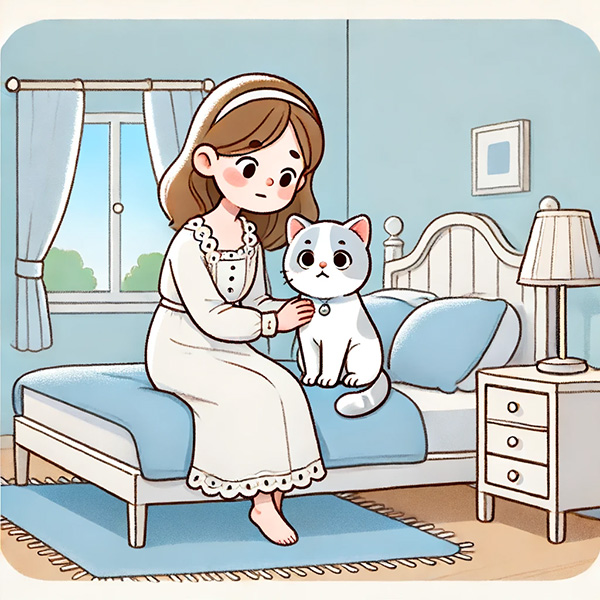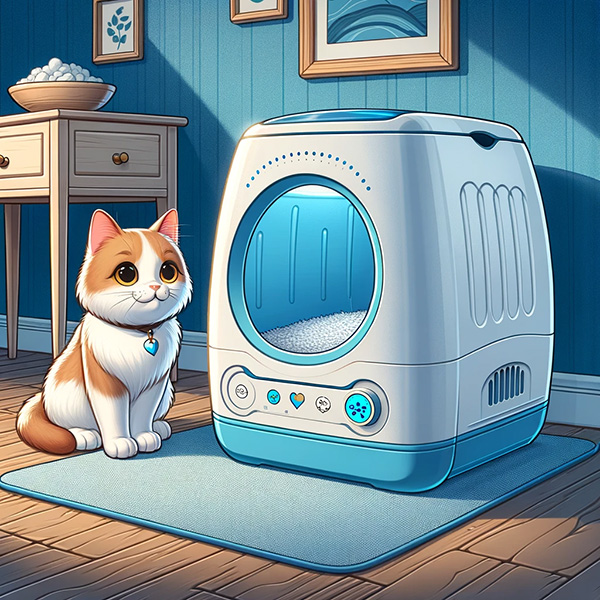As a cat owner, discovering your cat peed on your bed can be both frustrating and disheartening, not to mention the cat pee smell can be very hard to clean. This common issue among cat owners disrupts the comfort of your living space and signals that something may be amiss with your feline friend. To effectively tackle cat peeing on the bed, it is essential to comprehend the underlying reasons for this behavior. Whether it stems from medical issues, stress, environmental changes, or litter box preferences, each factor offers a clue into your cat’s well-being and comfort.
If you're wondering why your cat is urinating on the bed, rest assured—you're not alone in this experience. In this guide, we’ll explore various strategies to prevent this behavior, helping you restore harmony and ensure your cat remains healthy and happy in your shared home environment.
Ways To Stop Cat Urinating From Your Bed Based on Cause
Medical Causes

When a cat begins peeing on your bed, it's crucial to consider the possibility of underlying medical issues. Health issues such as urinary tract infections, bladder stones, diabetes, or kidney disease can cause discomfort, prompting cats to exhibit inappropriate urination behaviors such as opting for your bed instead of the litter box. Cats might associate the pain they feel during urination with the litter box and seek out more comforting places, such as your bed, where they feel safer or more secure.
The initial action to take to address this issue is to arrange a visit to the veterinarian. A thorough medical examination can diagnose any health problems causing the behavior. Treatment could range from antibiotics for a UTI to more specific medications or dietary changes for chronic conditions like diabetes or kidney disease.
In addition to medical treatment, ensure the litter box is as inviting as possible to discourage your cat from using your bed as an alternative. Maintain cleanliness in the litter box, ensure it's easily reachable, and place it in a quiet spot at home. Opt for a litter box with lower sides for easier access for older or physically challenged cats. Managing the medical issues and welcoming the litter environment can effectively stop your cat from peeing on your bed and restore their health and well-being.
Stress and Anxiety

Stress and anxiety are significant factors in cat urine in your bed. Such behavioral changes often result from disruptions within their environment or daily routines. Introducing new pets, other cats wandering around your yard, family members, or even large-scale renovations can unsettle your cat. Additionally, subtle changes such as alterations in your daily schedule or furniture rearrangement might disrupt your cat’s sense of security and routine.
Addressing this issue effectively involves creating a stable, secure environment and using cat treats as rewards. Try to keep your cat's routine as regular as possible, provide safe hideaways where your cat can retreat when overwhelmed, and use calming products like pheromone diffusers that can help alleviate anxiety.
Additionally, dedicating time for interaction—playing, grooming, or simply sitting together can significantly reduce your cat's stress levels. In cases where the behavior persists, consulting with a veterinarian or a cat behaviorist for tailored advice might be necessary. Reassuring your cat through consistent and comforting practices is key to helping them feel secure and stopping inappropriate urination.
Cat's Litter Box Issues

Cat litter box problems are a common reason why cats pee on your bed, and addressing these issues requires a detailed understanding of what makes a litter box appealing or unappealing to a cat. Several contributing factors require thoughtful consideration and adjustment.
Location
The placement of the litter box is crucial. It should be in a quiet, easily accessible area where the cat feels secure. Avoid placing the litter box in high-traffic areas, near the food and water bowls or near noisy household appliances like washing machines, as the noise and activity can discourage your cat from using the box. If you live in a multi-story house, consider placing a litter box on each floor to make it easy for your cat to reach a box when needed.
Cleanliness
Cats have a strong sense of cleanliness, and a dirty litter box is one of the most common reasons they seek alternative places to urinate. Ensure that the litter box is scooped at least once a day, the litter is completely changed, and the box is thoroughly cleaned regularly. Using unscented, clumping litter generally helps keep the box cleaner and is often more attractive to cats, who the strong odors of scented litter may put off.
Type of Litter
Cats have preferences when it comes to the type of litter. Some may favor finer textures, while others prefer pellet-like consistencies. Experiment with various types to find out what your cat prefers. Avoid using litters with deodorants or strong scents, as these can be irritating to cats.
Accessibility
Accessing the litter box can be challenging for older or physically impaired cats, which can discourage use. Make sure the litter box has low sides for easy entry and exit. A shallow storage container can be converted into a suitable litter box for cats with severe mobility issues by cutting one side low enough to step over.
Number of Litter Boxes
Having the right number of litter boxes in a multi-cat household is very important because having too few litter boxes can lead to competition and stress, which may cause a cat to avoid using the litter box altogether, resulting in the cat urinating elsewhere. A common recommendation is to provide one additional litter box beyond the number of cats in the household. This helps reduce territorial stress in a household with more than one cat and gives each cat plenty of opportunities to use the box without interference.
Territorial Marking

Cat peeing on the bed is particularly common in homes with multiple pets, where cats must establish dominance or delineate their territory. Cats use cat pees to mark their territory in response to stress or changes in their environment, such as the introduction of new pets, a new family member moving in, or even rearrangements within the home.
Understanding and managing the dynamics within your household is crucial to address and mitigate territorial marking. First, ensure each cat has its own space and resources, including separate litter boxes, feeding areas, and resting spots. Reducing competition over shared resources can decrease stress and the need to mark territory aggressively.
Additionally, consider using pheromone diffusers; these can help calm your cats and reduce the urge to mark. Pheromones mimic the chemicals cats naturally produce to communicate peace and familiarity, making them feel more secure in their environment.
In cases of persistent territorial marking, consulting with a veterinarian or a feline behavior specialist can provide more personalized strategies. They might suggest behavioral therapies or, in some cases, medical interventions to reduce the behavior, especially if it stems from anxiety or stress. Regular interaction and play can also help strengthen your bond with your cat, making them feel more secure and less inclined to mark your bed as their territory.
Access and Comfort
It is common for a senior or physically impaired cat to urinate in bed. If an older or physically impaired cat urinates on the bed, it often stems from issues of access and comfort. As cats age or face physical limitations, accessing a litter box—especially one with high sides or located far from their favorite resting spots—can become challenging. The bed provides an easily accessible alternative that also offers the comfort of soft bedding and the familiar scent of their human companions.
To address these issues effectively, first, assess the setup of your current litter boxes. Consider the height and entry point of the box. For older or impaired cats, litter boxes with low sides or a cut-out for an entrance can make it easier for them to get in and out without pain or difficulty. Additionally, placing litter boxes on each floor of your home or closer to where your cat spends most of its time can reduce the physical strain of reaching the box.
It's crucial to prioritize the comfort of the litter material. Some older cats prefer finer, softer litter that is gentler on their paws. Trying out various types of litter can assist in finding one that your cat prefers and finds comfortable to use.
Lastly, consider creating a comfortable rest area near their litter box with favorite blankets or a heating pad to encourage use. By making these adjustments, you can help alleviate the discomfort or accessibility issues your cat may be experiencing, thus discouraging them from using your bed as a bathroom.
Behavioral and Emotional Factors

Behavioral and emotional factors can significantly influence a cat's decision to pee on your bed. Such behaviors often arise from stress, anxiety, or a need for attention, which can be triggered by changes in the household, such as new family members, pets, or even a change in the owner's daily routine. Cats might also exhibit this behavior if they feel neglected or their environment lacks sufficient stimulation.
To address and ultimately stop this behavior, it's important to identify and mitigate the underlying emotional triggers. To reduce stress and anxiety, create a stable, comforting environment, and maintain a consistent routine. Provide safe hiding places and ensure your cat can access quiet, undisturbed spots around the house.
Increase interactive playtime to alleviate anxiety and strengthen the bond between you and your cat. Toys that stimulate hunting instincts, like laser pointers or feather wands, are especially effective. Also, consider environmental enrichment like window perches or cat trees that offer a view outdoors, which can keep your cat entertained and engaged.
Additionally, using pheromone diffusers or sprays can help calm your cat and make it feel more secure in its environment. If behavioral problems persist, seeking guidance from a veterinarian or a professional animal behaviorist may be necessary to create a customized approach that meets your cat's specific needs. These steps will help stop your cat from peeing on your bed and improve its overall well-being and happiness.
Preference and Comfort

When cats choose to pee on your bed, preference, and comfort can often be driving factors behind this behavior. Cats are particularly sensitive to their environment, and if the cat's litter box doesn't meet their standards for cleanliness, location, or the type of litter used, they might opt for a more comfortable spot—like your bed. A bed's soft, familiar-smelling environment can be far more appealing than a litter box that isn’t up to par.
To redirect this behavior, making the cat litter box as inviting as possible is essential. Begin by assessing the current litter setup. The box should be in a quiet, accessible location, away from noisy household appliances and high-traffic areas. Make sure to clean it regularly by scooping daily and replacing the litter entirely at least once a week. Try out various kinds of litter; certain cats may like fine-grained substrates, while others might prefer unscented options to scented ones.
Moreover, the physical comfort of accessing the cat litter box, especially for older cats or those with mobility issues, should be considered. A box with lower sides might be necessary to accommodate them comfortably.
If your cat has developed a strong preference for your bed, take steps to make it less appealing. Use waterproof mattress protectors and remove any additional blankets or pillows that might attract your cat when you're not in the room. Simultaneously, the appeal of the litter box can be enhanced by placing it in an ideal location and maintaining its cleanliness and accessibility. Through these measures, you can help ensure your cat prefers their box over your bed, maintaining both comfort and hygiene in your home.
Basic Needs Aren't Met
When a cat starts peeing on your bed, it might signal that its basic needs—safety, security, and stimulation—are not being fully met. A cat’s environment profoundly influences its behavior, and if it feels insecure or understimulated, it might resort to peeing in places where it seeks comfort, such as your bed.
Safety and security can be compromised if a cat feels threatened in its home environment. This could be due to the presence of other pets, loud noises, or even frequent guests. Ensure your cat has a safe haven in your home, a quiet place to retreat without fear of disturbance. This area should include its own bed, toys, and perhaps even a separate litter box.
Providing regular mental and physical stimulation is crucial for cats to maintain their health and happiness. Lack of playtime or interactive toys can lead to boredom and stress, which might cause them to urinate outside the litter box. Incorporate daily play sessions with your cat using interactive toys that mimic prey movements, provide puzzle feeders that challenge them mentally, and ensure they can access window perches or safe outdoor enclosures to observe the world.
To specifically stop your cat from peeing on your bed, reinforce the idea that the bed is not a place for elimination. Use waterproof covers to protect your bedding during training, and consider placing a cat bed nearby equipped with familiar scents to attract them. Gradually introduce more appealing litter box options, such as low-entry boxes for easier access, placed in quiet, secure areas. Meeting these fundamental needs will prevent your cat from urinating on your bed and improve their overall well-being and contentment.
